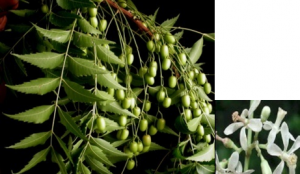|
Division
|
Angiosperms |
|
Class
|
Dicotledons |
|
Subclass
|
Polypetalae |
|
Series |
Disciflorae |
|
Order |
Geraniales |
|
Family |
Meliaceae |
|
Genus |
Azadirachta |
|
Species |
indica |

|
Etymology:
|
Derived from Persian “Azad Dhirakat”, excellent tree or noble tree as the wood, leaves and fruits are useful. |
|
Botanical name:
|
Azadirachta indica A. Juss. |
|
Local/Trade names: |
Neem tree, Margosa |
|
Conservation status:
|
Cultivated throughout India. |
|
Digonestic features: |
Bark, twigs and leaves are bitter. |
|
Description: |
Large tree. Leaves imparipinnate, 20-40 cm long; leaflets 9-15, sub opposite, 5-8 x 3 cm, lanceolate or ovate-lanceolate, unequal-shaped, often falcate. Flowers white, axillary panicles, shorter than the leaves. Fruit a drupe upto 1 cm long, ovoid-oblong, greenish-yellow when ripe. |
|
Phenology:
|
Fls.: Mar-Apr. Frts.: July-Aug. |
|
Distribution:
|
Native of Myanmar. Cultivated throughout hotter part of India. |
|
Where to see it: |
Medicinal Plant Garden, Back Gate of Nursery, Left side Nursery, Nursery, Gate No. 2 side, Ornamental Flowering Section. |
|
Uses: |
Bark used in skin troubles. Leaves considered antiseptic, applied to boils in the form of poultice; decoction given for ulcers and eczema. Flowers tonic and stomachic. Berries purgative, emollient. Dried leaves placed in books for keeping away the moths. Odour of burning leaves kills insects. Seeds yield a non-drying oil used for skin affections. Neem Oil may be mixed with other oils and fats for the manufacture of washing soap; medicated soaps with the odour of Neem Oil are available. Nimbidin is the chief bitter principle of the oil. Neem toddy is occasionally obtained as an exudation from the upper part of some trees; used as a tonic. Timber employed for house-building purposes and for boards, panels, toys, and ploughs; termite proof. Fresh tender twigs used to clean teeth particularly in pyorrhea. |
Chief Conservator of Forests & Chief Wildlife Warden is the Head of the Department. There is one post of Conservator of Forests & two posts of Deputy Conservator of Forests viz.